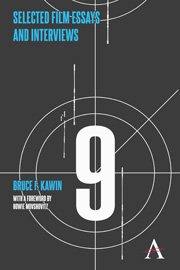Book contents
- Frontmatter
- Contents
- Foreword
- Preface
- PART I VIOLENCE AND POLITICS
- PART II HORROR AND SCIENCE FICTION
- PART III REVIEWS
- PART IV INTERVIEWS
- PART V LITERATURE AND NARRATION
- PART VI GETTING IT RIGHT
- 18 Creative Remembering and Other Perils of Film Study
- 19 Late Show on the Telescreen: Film Studies and the Bottom Line
- 20 Video Frame Enlargements
- 21 Three Endings
- Acknowledgments
- Index of Names and Titles
19 - Late Show on the Telescreen: Film Studies and the Bottom Line
from PART VI - GETTING IT RIGHT
Published online by Cambridge University Press: 05 May 2013
- Frontmatter
- Contents
- Foreword
- Preface
- PART I VIOLENCE AND POLITICS
- PART II HORROR AND SCIENCE FICTION
- PART III REVIEWS
- PART IV INTERVIEWS
- PART V LITERATURE AND NARRATION
- PART VI GETTING IT RIGHT
- 18 Creative Remembering and Other Perils of Film Study
- 19 Late Show on the Telescreen: Film Studies and the Bottom Line
- 20 Video Frame Enlargements
- 21 Three Endings
- Acknowledgments
- Index of Names and Titles
Summary
What can I say about this article except that most of it came true? (I was wrong to be apprehensive about the Library of Congress's National Film Registry, which turned out fine.) It offers a conservative perspective on film and video in 1988, when colorization was rampant and there were no DVDs or HDTVs, let alone 4K digital movies whose frames had the same number of pixels as film frames. Laserdiscs were catching on, but Blu-ray discs were far in the future. Most schools that used video used VHS or laser. It was published in Film Quarterly the following year. Things had changed a lot since I wrote “Creative Remembering, ” mainly for the better, but there was a new problem: film studies teachers were on the verge of abandoning celluloid in the classroom.
At the 1988 joint meeting of the University Film and Video Association and the Society for Cinema Studies (whose official topic was “the relationship of theory to practice”), there were several papers and panels devoted to the relative merits and values of film and video.
The film image was rated superior (be thankful for small favors), but the way this praise was rendered may prove of some interest. It was not that the frame of film—with its dyes, its silver, its tidepool emulsion—stored and yielded an image whose colors and other pictorial values were superior to and of an entirely different nature from the pictorial values of electronic imagery—not, in other words, that the film image alone could be the film image—but that the frame of film had the greater number of pixels.
- Type
- Chapter
- Information
- Selected Film Essays and Interviews , pp. 180 - 186Publisher: Anthem PressPrint publication year: 2013



